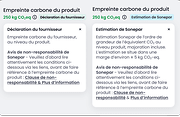EMPREINTE CARBONE PRODUIT SONEPAR
En avril 2023, Sonepar a dévoilé sa raison d’être « Powering Progress for Future Generations (Pour les générations futures, donnons de l’énergie au progrès) », assortie de six engagements forts L’un de ces engagements s’intitule « Parcours durable du client » et vise à donner aux clients les connaissances et les outils nécessaires pour faire des choix respectueux de l’environnement.
De plus en plus de clients, de petits, moyens et grands installateurs ainsi que des entreprises industrielles demandent des informations complètes sur le CO2 pour les aider à gérer et à réduire leur empreinte carbone. L’incapacité de fournir ces informations est inconcevable pour Sonepar. Le groupe est également conscient que le secteur de l’électricité n’est pas encore suffisamment mature pour couvrir l’ensemble de son portefeuille avec des données carbone et des déclarations environnementales de produit (DEP) fournies par ses partenaires.
Dans cette optique, Sonepar estime qu’il est temps de fournir aux clients des informations sur l’empreinte carbone des produits à grande échelle. Le groupe a donc développé L’Empreinte carbone produit, une innovation portée par l’IA et lancée en 2025 pour couvrir son portefeuille avec des données relatives à l’empreinte carbone. Parallèlement, Sonepar soutiendra toute initiative visant à améliorer les normes sectorielles en matière de comparabilité et d’accessibilité de l’empreinte carbone.

Qu’est-ce que l’Empreinte carbone produit ?
L’Empreinte carbone produit est un indicateur exprimé en kilogrammes de CO2 équivalent par produit, issu soit directement des informations fournies par un fournisseur, soit d’une estimation calculée par Sonepar. L’équivalent CO2 est une unité de mesure utilisée pour comparer les émissions de différents gaz à effet de serre (dioxyde de carbone, méthane, etc.) en les ramenant à une référence commune : le dioxyde de carbone (CO₂).
Sonepar et Cebeo encouragent ses fournisseurs à indiquer, pour chacun de leurs produits, l’empreinte carbone en kg CO₂-eq ou la contribution au réchauffement climatique en fournissant leurs propres données. Dès que Sonepar les reçoit, ces informations sont publiées dans la fiche descriptive du produit.
Si elle ne reçoit pas ces informations de la part de ses fournisseurs, Sonepar propose un ordre de grandeur des émissions de CO₂-eq par produit, indépendant du fournisseur, en se basant sur des estimations réalisées à partir des données disponibles.
Sonepar affiche alors le total en kgCO₂-eq sur la page produit, calculé sur l’ensemble du cycle de vie du produit, depuis l’extraction des matières premières (cradle) jusqu’au traitement des déchets (grave), en passant par la production, l’assemblage et la (ré)utilisation.
Un facteur d’incertitude (majoration ou pénalité) est également appliqué à cette estimation afin de tenir compte du niveau d’incertitude supplémentaire par rapport aux données carbone – et en particulier aux déclarations environnementales de produit – fournies par les fournisseurs. Une clause de non-responsabilité informe également les clients que cette information relative au CO₂-eq n’a qu’une valeur indicative et représente un simple ordre de grandeur.
Comment puis-je différencier une déclaration du fournisseur d’une estimation de Sonepar ?
Les informations fournies par un fournisseur sont signalées par une icône « Déclaration du fournisseur », tandis que celles issues d’une estimation de Sonepar s’accompagnent d’une icône « Estimation de Sonepar », comme illustré ci-dessous :

L’icône « Déclaration du fournisseur » indique que des données environnementales relatives au CO2-eq sont disponibles et qu’elles émanent d’un fournisseur.
L’icône « Estimation de Sonepar » indique que le CO₂-eq repose sur la méthodologie développée par Sonepar et qu’il fournit un ordre de grandeur.
Quels sont les avantages pour les clients et les utilisateurs finaux ?
Les clients de Sonepar peuvent agréger les données CO2-eq pour calculer les émissions totales du cycle de vie des devis, des projets à grande échelle ou des bâtiments entiers. Les clients finaux bénéficieront de ces résultats lorsqu’ils calculeront l’empreinte carbone de leur maison ou de leur projet. À des fins réglementaires, l’Empreinte carbone produit peut également aider les clients à évaluer leur empreinte carbone de scope 3 liée à l’achat de produits électriques.
Les valeurs de CO₂-eq sont-elles comparables entre deux produits d’une même catégorie ?
L’Empreinte carbone sert d’indicateur pour évaluer l’ordre de grandeur des émissions de CO₂-eq d’un produit.
Qu’elle provienne d’une empreinte carbone fournisseur, d’une déclaration environnementale de produit ou d’une estimation de Sonepar, cette donnée ne doit pas servir de base à une comparaison entre produits, et ce pour les raisons suivantes :
- Les données d’empreinte carbone fournisseur et les déclarations environnementales des produits : Les fournisseurs utilisent des mix électriques, des bases de données et des méthodes de mesure des caractéristiques techniques différents pour calculer les émissions de CO₂-eq de leurs produits. De ce fait, les émissions de CO2 de ces déclarations ne sont pas établies selon les mêmes normes.
- Sous-catégorisation des produits : En ce qui concerne l’estimation de Sonepar, le CO₂-eq est déterminé à partir de sous-catégories de produits, une subdivision du modèle ETIM (Electro-Technical Information Model) fondée sur les caractéristiques des produits. Elle ne doit donc pas être utilisée pour comparer les produits d’une même catégorie entre eux.
Toutefois, la méthodologie peut, dans une certaine mesure, aider les clients à effectuer des arbitrages entre différentes technologies. Elle est par exemple utile pour comparer des lampes fluorescentes à des lampes LED ou des pompes à chaleur à des chaudières au gaz, car elle fournit un ordre de grandeur.

Puis-je utiliser l’Empreinte carbone produit dans le monde entier ?
Son utilisation à l’échelle mondiale est envisageable, mais certaines limites s’appliquent. La phase d’utilisation est généralement la plus déterminante pour les produits électriques, car c’est durant cette phase qu’ils consomment de l’énergie. Pour les déclarations de fournisseur, le mix électrique retenu est généralement le mix européen, mais il peut aussi s’agir du mix local propre à un pays, comme précisé dans le document du fournisseur.
Pour l’estimation de Sonepar, et par souci de simplicité, le mix électrique retenu est le mix européen. Le mix européen est d’environ 213 g CO2-eq/kWh en 2024, tandis que le mix américain est d’environ 361 g CO2-eq / kWh (source : Ember European Electricity Review 2025). Par conséquent, la phase d’utilisation aurait un poids encore plus marqué aux États-Unis. Cette approche peut donc présenter certaines limites en dehors de l’Europe, mais puisqu’aucune comparaison n’est effectuée, son utilisation reste acceptable.
Où trouver l’Empreinte carbone produit ?
L’Empreinte carbone produit est affichée sur les plateformes nationales de commerce électronique de Sonepar. Cette initiative est gérée par l’équipe Green Offer au sein de l’équipe Digital Transformation de Sonepar.
En quoi l’Empreinte carbone produit diffère-t-elle de la Green Offer ?
En 2022, Sonepar a lancé la Green Offer, une initiative unique au monde qui permet de comparer la performance environnementale des produits à un niveau individuel. Fondée sur une méthodologie vérifiée de manière indépendante, la Green Offer attribue aux produits une note allant de A à C en fonction de leur empreinte CO₂-eq sur l’ensemble de leur cycle de vie.
Bien que plus granulaire, la Green Offer est limitée par la maturité de l’industrie, notamment en termes de disponibilité et de comparabilité des données sur le CO2 et des caractéristiques techniques des produits. Pour y remédier, l’initiative Empreinte carbone produit, qui combine les données carbone déclarées par les fournisseurs et les estimations de Sonepar, vise à remplacer la Green Offer en fournissant des ordres de grandeur pour une gamme plus large de produits en portefeuille.
Une initiative ambitieuse qui s’inscrit dans le cadre d’un parcours client durable plus large et d’une stratégie de développement durable omnicanale.
Le lancement de l’initiative Empreinte carbone produit marque un pas en avant important dans la fourniture de données transparentes sur les gaz à effet de serre (GES) dans le secteur de la distribution d’équipements électriques. Bien qu’il s’agisse d’une étape majeure, beaucoup reste à faire. Sonepar s’engage à accélérer ces progrès en mettant en valeur l’intérêt des données d’émissions transparentes et en encourageant activement ses fournisseurs à publier davantage de déclarations environnementales de produit (DEP).
Sonepar a pour objectif d’intégrer la durabilité à chaque étape de son parcours client omnicanal, afin de garantir une expérience d’achat entièrement durable. Grâce à ses plateformes numériques, Sonepar intégrera l’écoresponsabilité dans les interactions avec les clients, de la sélection des produits à la livraison, afin de leur permettre de faire des choix éclairés et respectueux de l’environnement.
Dans cette dynamique, Sonepar continuera d’innover en développant de nouveaux services et outils numériques destinés à aider ses clients à mesurer, maîtriser et réduire leur empreinte environnementale. Ces efforts visent à favoriser l’adoption à long terme de produits et de solutions durables de la part de ses fournisseurs, en renforçant la collaboration tout au long de la chaîne d’approvisionnement.
Cette vision va au-delà des mesures de carbone. Elle s’inscrit dans une stratégie de développement durable plus large, axée sur la préservation de l’environnement, la conservation des ressources naturelles et la protection des personnes contre les substances dangereuses. Ces priorités sont de plus en plus urgentes pour la société et sont au cœur de la raison d’être de Sonepar : Pour les générations futures, donnons de l’énergie au progrès.



